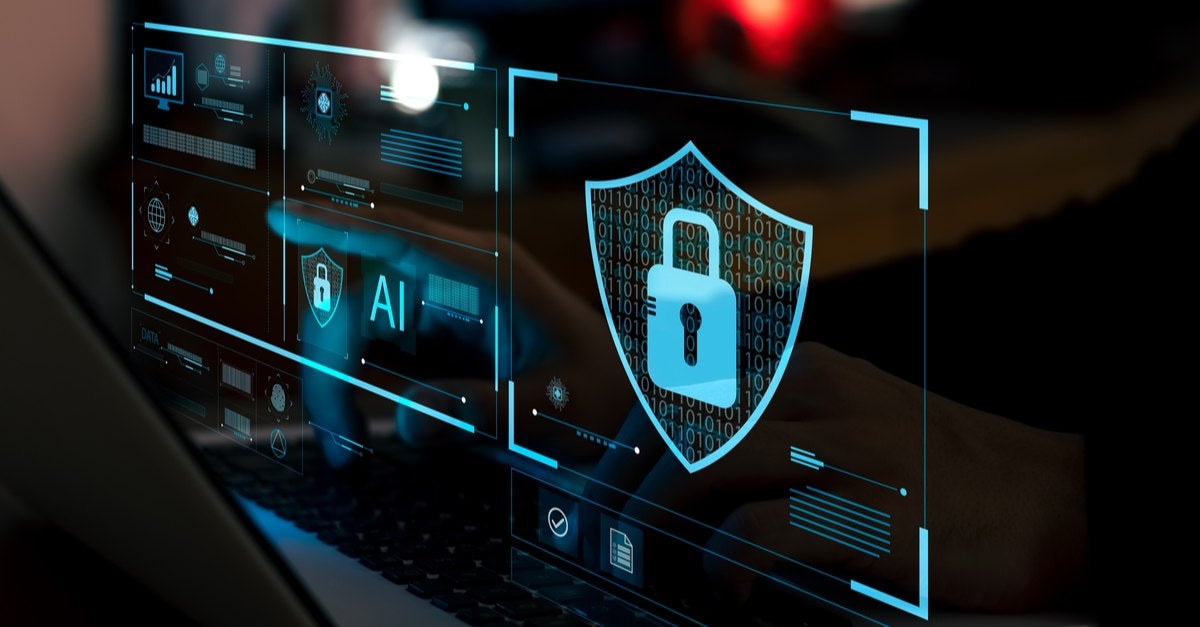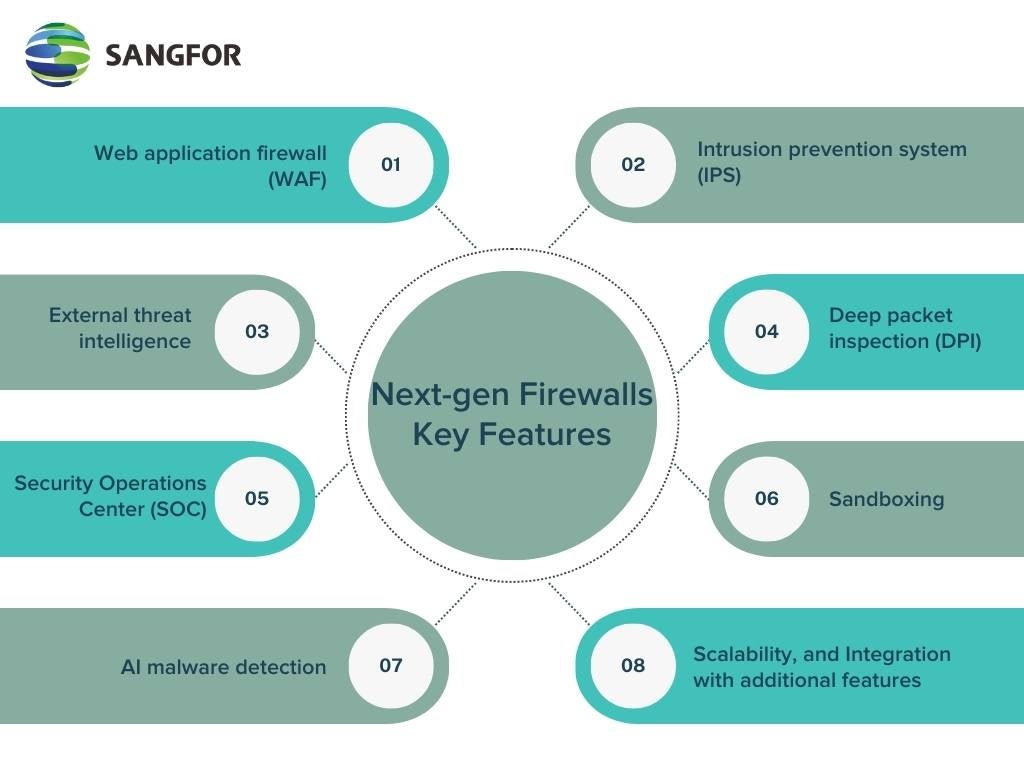A Next-Generation Firewall (NGFW) is a cybersecurity device that combines traditional firewall functions with advanced features like deep packet inspection (DPI), intrusion prevention systems (IPS), and application-level filtering. NGFWs protect networks up to Layer 7 of the OSI model, offering superior security against modern threats like ransomware, zero-day exploits, and unauthorized applications.
Read more about the history of firewalls here. Perhaps the best way to understand next-gen firewalls is to compare them to traditional firewalls.

How an NGFW Safeguards Your Network
Network Firewalls serve as the gatekeepers of network perimeters. Within an NG firewall, all traffic undergoes thorough scrutiny by this protective barrier. This scrutiny empowers the firewall to enforce security policies, deciding whether to allow or disallow the passage of data.
An NGFW enhances the capabilities of a traditional firewall by incorporating additional functionalities. Most notably, it operates at the application layer of the TCP/IP stack, enabling the implementation of features such as intrusion prevention systems (IPS), anti-malware defenses, sandboxing, and other security measures. These features enable an NGFW to detect and proactively block advanced threats, thereby safeguarding corporate systems from potential risks.
The differences between next-gen firewalls and traditional firewalls
Cyber attacks can target any of the seven Open Systems Interconnection (OSI) layers, though traditional firewalls only protect up to Layer 4, focusing on basic packet filtering and stateful inspection. This leaves higher-level vulnerabilities exposed.
Next gen firewalls (NGFWs) extend protection up to Layer 7, enabling deeper traffic inspection and application-level filtering. They combine traditional firewall functions with advanced features like intrusion prevention, AI-powered threat intelligence, and centralized management. For instance, Sangfor’s Network Secure is interlinked with an intrusion prevention system, AI-backed external threat intelligence offering robust, integrated security beyond what traditional firewalls can provide.
| Aspect | Traditional Firewalls | Next-Gen Firewalls (NGFWs) |
|---|---|---|
| OSI Model Coverage | Operate up to Layer 4 (Transport layer) | Extend to Layer 7 (Application layer) |
| Functionality | Basic filtering and stateful inspection | Deep packet inspection, application-level filtering |
| Protection Scope | Limited protection, mostly against lower-layer attacks | Broader protection, including higher-layer threats |
| Traffic Analysis | Analyzes packet origin and destination | Analyzes packet content, origin, destination, and behavior |
| Integration | Typically standalone | Integrated with other cybersecurity tools (e.g., IPS, threat intelligence) |
| Security Approach | Reactive and limited | Proactive and dynamic |
The Benefits of Next-generation Firewalls
Next gen firewalls offer enhanced security compared to traditional firewalls. Traditional firewalls have limitations, as they can only block traffic by port and lack application-specific rules, malware protection, and the ability to detect and block unusual behavior. This leaves them susceptible to attackers using nonstandard ports. In contrast, next-generation firewalls provide context-aware security and can receive updates from external threat intelligence networks. They protect against a wide range of advanced threats, often employing intelligent automation to keep security policies current without IT staff intervention.
Moreover, next-generation firewalls streamline security infrastructure, making it more cost-effective and manageable. They consolidate multiple security features into a single solution and report incidents through a unified reporting system. This approach reduces the workload on IT staff and minimizes the risk of security breaches compared to maintaining multiple separate security products.
What Are the Key Features to Look for in a Next-Gen Firewall?
Not all NGFW firewalls are the same. Many can be adjusted to suit the specific organization’s needs. Next-gen firewalls may include features such as:

Web Application Firewall (WAF)
A next gen firewall can filter up to layer 7 in the OSI model. Sangfor Network Secure is integrated with Sangfor WAF to provide this level of protection.
An Intrusion Prevention System (IPS)
An intrusion prevention system (IPS) (different from an intrusion detection system, or IDS) monitors the network for threats and eliminates them immediately.
External Threat Intelligence
Next gen firewalls are often combined with external threat intelligence to boost effectiveness at spotting threats. For example, Sangfor Network Secure is integrated with Sangfor Neural-X - a cloud-based, AI-powered threat intelligence and analytics platform.
Deep Packet Inspection (DPI)
Deep packet inspection is when the firewall examines not only the source and destination of a packet but its contents too.
Security Operations Center
A security operations center (SOC) acts as a centralized location to control and manage a firewall among other security tools.
Sandboxing
Sandboxing provides a way to safely test these files in a controlled and isolated environment. Sandboxing technology, such as Sangfor ZS, is often bundled with NGFW packages.
AI Malware Detection
Sangfor Network Secure works with Engine Zero, our proprietary AI-powered real-time Malware Detection Engine which uses machine learning and AI algorithms to detect malware at a 99.76% success rate.
Scalability
Next-gen firewalls are commonly offered as a service from a securities vendor like Sangfor offering easy scalability as your organization grows.
Streamlined and Agile Management
Next-gen firewalls often come with a centralized Security Operations Center (SOC) that offers a user-friendly control panel for easy oversight and management.
Integration with additional features
Firewalls can be combined with a range of other solutions. For example, many are integrated with application control, endpoint detection and response software, and much more.
Why do businesses need next-gen firewalls?
Without a firewall, your network is far more vulnerable. And, through weaknesses in this network, organizations may fall victim to a cybersecurity incident. But as we've mentioned, not all firewalls are made equal. Specifically, next-gen firewalls are much better equipped than traditional firewalls with their robust and comprehensive security capabilities, layer seven application filtering, and more. When it comes to protecting your organization against newer and more dangerous threats, they are a must-have.
It is worth remembering that next-gen firewalls should only be one part of a holistic security architecture. Together with other solutions such as incident response plans, endpoint security, and more, next-gen firewalls help provide coverage for all levels of the OSI model.
Protect your business with Sangfor
Sangfor is a leading cybersecurity vendor offering a range of solutions. Everything from next-generation firewalls to internet access gateways is available as services.
Sangfor believes that Security should be easy to understand, deploy and operate for all organizations. If you haven't explored the enormous benefits of Sangfor Network Secure Next Generation Application Firewall (now Sangfor Athena NGFW) for your business network security, now is the time. Check out the Sangfor Network Secure video to get an informative overview of Sangfor's NGFW with information on all the newest and most exciting innovations and features, like Next Generation, WAF, Neural-X, Engine Zero and Security Butler.
Sangfor's NGFW has garnered significant success, as evidenced by its broad range of case studies.
- The Institute of Chartered Accountants of Pakistan – or ICAP, uses the advanced Next-Generation Firewall to protect the institution. The solution offered enhanced malware detection and threat intelligence to ensure that cyber threats remain controlled and effectively removed without any damage to the network or data of the organization.
- The National Information Technology Board (NITB) offers advanced IT support to federal authorities. It uses Sangfor's Next-Generation Application Firewall for holistic and simplified web server protection. With the help of Sangfor's solutions, it can effectively provide advanced IT infrastructure for government bodies in Pakistan.
To learn more about what a next-gen firewall is or about specific features, get in touch with us.
Contact Us for Business Inquiry
Frequently Asked Questions
The most crucial part of a next-gen firewalls capabilities is its application-level filtering. This means that NGFWs are able to provide protection up to layer 7 in the OSI model. This, together with a range of incorporated features, empowers NGFWs to prevent a huge array of cyber security incidents. Everything from malware, ransomware, SQL injections, cross-site scripting, and more can be eliminated by an NGFW.
Sangfor NGAF holds several world-first titles when it comes to next-gen firewalls, including:
- The first AI-enabled NGFW
- The first to integrate WAF and SOC
- The first to truly integrate network and endpoint security solutions
The constant strive to create the most effective firewall is what makes Sangfor a leading vendor in the market. We are wholly committed to finding new ways of improving NGAF as threats evolve. Furthermore, NGAF presently provides one of the most comprehensive security systems when working together with other Sangfor solutions.
All businesses handle sensitive data; many hold confidential client information and follow strict compliance requirements. Next-gen firewalls are geared toward these businesses so that they can keep their information and systems secure. While smaller businesses may be able to get away with simpler solutions, we would always recommend a next-gen firewall. Our solutions are easily scaled depending on business growth and can be priced accordingly.





